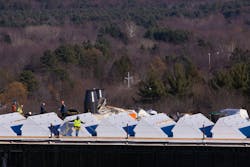Continuous air replacement is typically the top operating expense in facilities such as science centers, laboratories and hospital environments where no air recirculation is permitted. Ambient air is continuously pulled from outside, filtered to remove impurities, fed through the facility and then exhausted out. In this way, such things as toxic chemicals, combustible substances, flammable solvents, harmful organisms, noxious vapors and other contaminants are expelled from the environment.
This is a great way to ensure the integrity of incoming air. But it drives up costs. Laboratories, for example, consume four to six times more energy per square foot than standard office or commercial buildings. For many facilities, there is no way around this. They are subject to a variety of regulations and standards that demand no recirculation of inside air to prevent back contamination. However, the replacement of that air consumes a lot of energy. And with many facilities intent on lowering their carbon footprints, this has become a big area of concern.
The situation worsens in the warm summer months. The air must be cooled to bring down the temperature to a comfortable level, typically via a campus chiller plant. Costs soar once again.
Some facilities keep expenses in check by installing an exhaust heat recovery system and a run-around coil. This solution works well but struggles during the hotter summer months. By adding supplementary evaporative cooling to cool the air before it hits the run-around coil, energy costs can be greatly reduced. Overall, the combination of a run-around coil and fog-based cooling of exhaust air slashes cost by about one third with a corresponding reduction in the carbon footprint.
Improved Exhaust Heat Recovery System Design
Van Zelm Engineers of Farmington, Connecticut, has designed many campus and district central energy plants and distribution loops using a sustainable approach. Eric Fontaine, P.E., Senior Associate at van Zelm Engineers, finds that designing a sustainable laboratory building presents numerous challenges.
“Perhaps the biggest challenge is reducing the energy used for conditioning the ventilation air in a building with inherently high ventilation rates and potentially contaminated exhaust streams while satisfying code requirements and maintaining a safe environment,” said Fontaine. “Selecting the proper energy recovery system approach represents the most important decision in the design of an energy efficient laboratory HVAC system.”
Based on his company’s analysis of heat recovery options for the laboratory exhaust systems, the most efficient way to achieve this is by feeding hot exhaust air through a run-around coil loop. The loop moves heat from one air stream to another via heat exchangers. This has been found to be the only efficient way to transfer heat between two air streams that cannot be directly connected for reasons of safety or practicality. Pipework is charged with a heat exchange fluid such as water or glycol, which picks up heat from the exhaust air coil and gives up heat to the supply air coil. This is connected to the chiller system to raise efficiency and lower the energy load on the chiller system. As the two air streams are separate units, there is no threat of exhaust contamination.
Konvekta of Princeton, New Jersey, manufactures a glycol run-around loop that has proven successful in many facilities throughout Europe and is now gaining traction in US colleges, labs and hospitals. This closed-loop system extracts energy in the form of cold or heat from the exhaust air of buildings and returns it to the supply air efficiently. This is achieved via well-designed heat exchangers coupled with optimization and control software. The heat exchangers have headers on both sides to create countercurrent flow. This makes the units compact and efficient. Software takes into account the building configuration as well as meteorological data for an entire year. This enables its operation to be adjusted appropriately with the changes in the seasons. Van Zelm Engineers have more than 15 years of experience with this system.
“The controls calculate the amount of energy available at any time and make adjustments to recover as much energy as possible,” said Fontaine. “The typical run-around loop can perhaps reach 55% energy recovery whereas Konvekta can reach 70% and beyond due to its built-in intelligence.”
Cooling Augmentation for Added Efficiency
The heat exchange efficiency of the system is further increased by precooling the exhaust air using a fog cooling system by Mee Industries of Irwindale, California.
“In summer, the performance of traditional glycol loop systems is limited by the intake and exhaust airstream temperature difference, resulting in minimal energy recovery,” said Fontaine. “MeeFog brings the exhaust air temperature down before it reaches the loop, which increases the amount of energy you can recover.”
Fogging adiabatically cools the exhaust air by 10 to 15 degrees F. via the evaporation of microfine fog droplets before it hits the glycol loop exhaust energy recovery system. Thus, the workload on the large centrifugal chillers used to cool the outside air is considerably reduced.
The fogging system consists of an array of fog nozzle lines installed in the exhaust air flow prior to it reaching the glycol loop. As the droplets are tiny, they stay airborne to maximize the evaporative cooling potential. A series of staging valves are included so that the right amount of fog can be applied to achieve the desired level of cooling. As the summer afternoon temperatures rise, more stages are opened.
Fog systems atomize high-pressure water (1000 to 2000 psi) through a network of 316 stainless steel tubes and impaction-pin fog nozzles which feature an orifice with a diameter of 150 micrometers. The result is a fog containing billions of ultra-fine droplets of pure water, averaging about ten microns in size. This fog is injected into the exhaust air where it evaporates to lower the temperature and increase the humidity of the air. The spray system controls ensure it produces maximum cooling without wasting water. Savings in running costs mean that a fogging system will typically pay for itself within one year. Energy consumption is nominal.
College Lowers Its Carbon Footprint
Amherst College in Massachusetts has embarked upon an ambitious plan to greatly reduce its carbon footprint by 2030. Major progress has already been made courtesy of a new science center that incorporates a great many sustainability features. These serve to both lower energy usage and improve overall efficiency.
Van Zelm Engineers was the engineer of record for the Amherst Science Center, responsible for building mechanical, electrical and plumbing (MEP) design. A design goal was to reduce energy usage by 73% compared to the typical science building via features such as HVAC efficiency, individual lab hood controls, an insulating building envelope, grouping of specialized labs, rainwater harvesting, rooftop solar and contracting additional solar energy from the Farmington Solar project in Maine.
An upgrade to the cooling system of the science building reduces the amount of energy required during the summer. A combination of a glycol loop and a fog-based evaporative cooling system augment the electric chiller plant.
“We developed and analyzed multiple heat recovery options for the laboratory exhaust systems and ultimately selected the combination of the glycol run-around system combined with the fogging system for indirect evaporative cooling,” said Fontaine of van Zelm, who works as project manager for the Science Center project. “Using MeeFog in the exhaust airstream during summer improves the heat recovery efficiency at peak design condition by over 50% and increases annual recovered cooling energy by over 400%.”
For the Amherst College Science Center, that translates into approximately 45 additional tons of peak chilled water savings. The total cooling recovery was calculated at 885 MM Btu in 2021 and 1,119 MM Btu in 2022.
“These numbers would have been at least 80% lower without MeeFog due to the outside air temperatures of 70 to 90 degrees F., where the system couldn’t recover any cooling energy without fogging,” said Fontaine. “The annual savings from the MeeFog system at Amherst amount to an average of 800 MM Btu.”
Raising Campus Efficiency
Van Zelm has worked on many higher education and other campuses. Fontaine noted that many facilities are already using evaporative fogging to humidify their environment in the winter when the air can become very dry. He suggested gaining further value from that fogging system by extending its usage into the summer months to augment a run-around loop.
“If you are already using fog for humidification in winter, all you have to do is get some extra piping for summer and you reduce your first costs and greatly increase the financial picture,” said Fontaine.
Those without fog-based humidification can still gain a fast return on investment. Van Zelm recently evaluated a system at a large university in Massachusetts that needed the system installed from scratch. Per Fontaine’s calculations, the energy recovery savings would pay for fogging within about three years.
“All energy intensive facilities such as laboratories, hospitals and industrial sites that include run-around heat recovery systems should consider adding a fog-based adiabatic cooling system,” said Fontaine. “It is relatively easy to accommodate and the payback rate for the system is favorable.”

